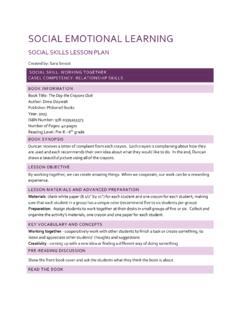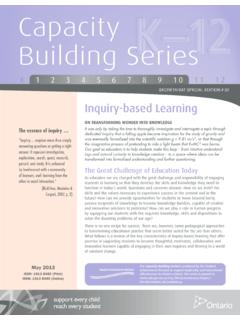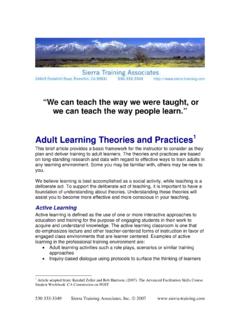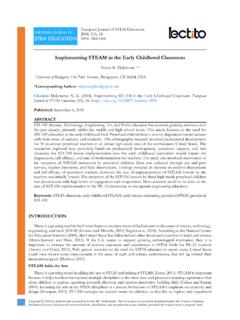Transcription of Creative Dance Integration Lesson Plans by Erika Cravath
1 1 Creative Dance Integration Lesson Plans by Erika Cravath23 AcknowledgmentsSupport for this project was provided by:I am sincerely grateful to the many people who assisted me in this project, including:Marilyn Berrett, my mentorDeAnn Sanders, my other mentorAll my students, who made this packet possibleClayton Cravath , my supportive husbandPartnershipBeverley Taylor SorensonArts Reaching & Teaching in Schools 2011 Erika CravathThis may be copied, distributed and posted for internet public access for personal, non-profit educational Commercial uses require the permission of the copyright curriculum standards were created by the Utah State Office of Education and are found at contact the author with questions or comments, email Cover art by Zachary WoffindenLayout by Heidi Israelsen45 Table of Contents Acknowledgments.
2 3 Introduction ..7 How to Use This Book ..9 Tips for Teaching Dance ..10 Other Ideas for Incorporating Dance into the classroom ..122nd Grade Lesson PlansMath: 2-Digit Addition with Regrouping ..14 Math: Number Ordering ..16 Math: Telling Time ( vs. ) ..18 Social Studies: Cultures Part I ..20 Social Studies: Cultures Part II ..22 Social Studies: Mapping ..24 Music: Music and : Musical Canon ..28 Language Arts: Row, Row, Row Your Boat ..30 Languages Arts: Homophones ..32 Language Arts: Prefixes un- and re- ..34 Science: Animal Adaptation.
3 36 Science: Winter Weather ..385th Grade Lesson PlansLanguage Arts: Essay Composition ..40 Science: States of Matter ..42 Science: Static Electricity ..46 Visual Art: Illustration ..48 Social Studies: The Charleston and Dance Culture in the 1920 s and 30 s .50 Math: Fractions ..52 Language Arts: Reading Comprehension ..54 Music: Musical Beats and Rhythm ..5667 Introduction Most elementary school teachers would agree that they have too many demands and too little time. After spending half the day on literacy, then squeezing in math, science, and social studies, few minutes remain for arts instruction, recess, creativity, and community- building activi-ties.
4 However, a well-rounded education is vital for children, who must learn Creative and critical thinking skills. Children learn in many ways, yet schools often cater to visual and linguistic learners, and kinesthetic learners can be seen as trouble makers. Elementary school teachers are expected to provide a well-rounded, enriching education to all types of learners, ensuring that basic curricu-lum standards and life skills are taught. This book provides a detailed description of my method of addressing the above problem: using Dance to teach and supplement the required curriculum.
5 Combining Dance with other cur-riculum areas is a student-centered approach that helps kinesthetic learners to better understand required class material. A fifth-grade student and kinesthetic learner said to me, Usually I don t understand science, but when you put movement into learning, I really understood all of it. Dance brings children a sense of novelty and anticipation. A second-grade teacher I worked with said, My class literally cheers when they see Dance on the schedule. My students absolutely love to Dance .
6 Through Dance , children can experience music and art from different cultures, pe-riods, and techniques, which promotes deeper understanding through experiential learning. Not only can Dance be used as a tool to teach curriculum, but also to teach creativity and critical thinking . Throughout the lessons in this book, students are given choices where they must decide how to solve a given Creative movement problem. Students learn to make independent decisions and to find confidence in their bodies. A fifth-grade student told me, I loved when we got to make up our own dances.
7 I felt like a pro. Although it does require a willingness from the teacher to try a new and different method of teaching, Dance in the classroom has incredible ben-efits, and all you need is a little preparation and a lot of dancing bodies!89 How to Use This Book This book is designed to give every elementary school teacher the tools he or she needs to begin incorporating Dance into every-day curriculum. On the next page, you will find teaching tips that are especially important when teaching Dance . The subsequent Lesson Plans in this book were specifically created for second and fifth grades, but could be adapted to fit younger or older grades as needed.
8 The Lesson Plans in this book are divided into sections based on Lesson content: Reading, Math, Science, Social Studies, Music, and Visual Art. Each Lesson is divided into four sections: Experience/Identify, Explore/Investigate, Create/Perform, and Connect/Analyze. These are called the Four Universal Principles of Learning, and are the result of extensive research in the learning process by Marilyn Berrett. Use these Lesson Plans to incorporate Dance into your own classroom , and feel free to adapt them as needed.
9 Following the Lesson Plans is a list of other topics and ideas to incorporate Dance into each curricular area. Try to create your own dancing Lesson Plans using the Lesson Plans and ideas in this book as a guide. Two years ago, I worked with a fifth-grade teacher who was terrified of Dance and every-thing that related to Dance . She did not know how to start using Dance in the classroom . How-ever, after team teaching a few lessons with me, she was ready to teach Dance on her own. She later wrote, As a grade level we rotate and teach the other classes our science lessons.
10 I have en-joyed incorporating some of the things Erika taught my class. It has helped me to become a better teacher. My goal for this book is to help you to become a more diverse, student-centered teacher, helping students of all learning styles to learn. For a digital copy of additional visual aids (specified for each Lesson if available), individual Lesson plan, or a copy of the entire book, please visit All materials can be found under the Resrouces tab in Activities and Tools, in addition to other arts integrated Lesson Plans in all four art for Teaching Dance Say when before what Describe when students will do something before describing what they will be doing.






